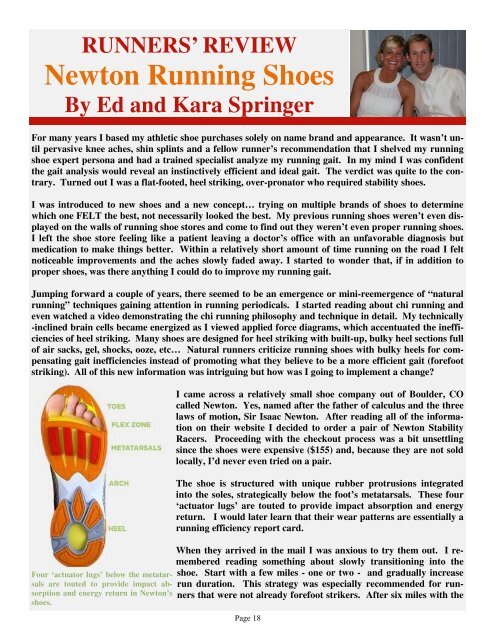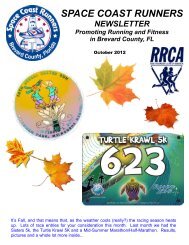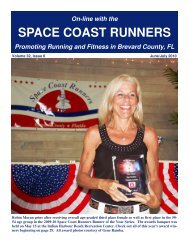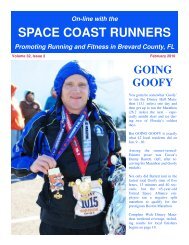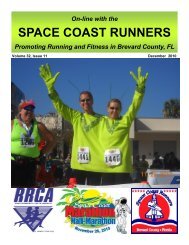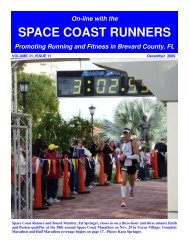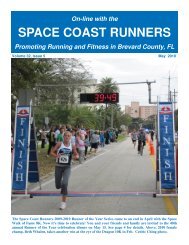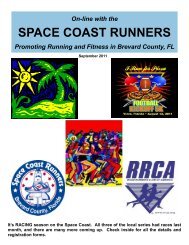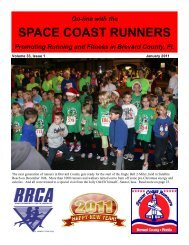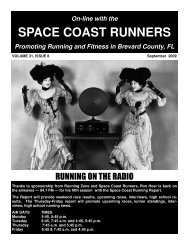Create successful ePaper yourself
Turn your PDF publications into a flip-book with our unique Google optimized e-Paper software.
RUNNERS’ REVIEW<br />
Newton Running Shoes<br />
By Ed and Kara Springer<br />
For many years I based my athletic shoe purchases solely on name brand and appearance. It wasn’t until<br />
pervasive knee aches, shin splints and a fellow runner’s recommendation that I shelved my running<br />
shoe expert persona and had a trained specialist analyze my running gait. In my mind I was confident<br />
the gait analysis would reveal an instinctively efficient and ideal gait. The verdict was quite to the contrary.<br />
Turned out I was a flat-footed, heel striking, over-pronator who required stability shoes.<br />
I was introduced to new shoes and a new concept… trying on multiple brands of shoes to determine<br />
which one FELT the best, not necessarily looked the best. My previous running shoes weren’t even displayed<br />
on the walls of running shoe stores and come to find out they weren’t even proper running shoes.<br />
I left the shoe store feeling like a patient leaving a doctor’s office with an unfavorable diagnosis but<br />
medication to make things better. Within a relatively short amount of time running on the road I felt<br />
noticeable improvements and the aches slowly faded away. I started to wonder that, if in addition to<br />
proper shoes, was there anything I could do to improve my running gait.<br />
Jumping forward a couple of years, there seemed to be an emergence or mini-reemergence of “natural<br />
running” techniques gaining attention in running periodicals. I started reading about chi running and<br />
even watched a video demonstrating the chi running philosophy and technique in detail. My technically<br />
-inclined brain cells became energized as I viewed applied force diagrams, which accentuated the inefficiencies<br />
of heel striking. Many shoes are designed for heel striking with built-up, bulky heel sections full<br />
of air sacks, gel, shocks, ooze, etc… Natural runners criticize running shoes with bulky heels for compensating<br />
gait inefficiencies instead of promoting what they believe to be a more efficient gait (forefoot<br />
striking). All of this new information was intriguing but how was I going to implement a change?<br />
Four ‘actuator lugs’ below the metatarsals<br />
are touted to provide impact absorption<br />
and energy return in Newton’s<br />
shoes.<br />
I came across a relatively small shoe company out of Boulder, CO<br />
called Newton. Yes, named after the father of calculus and the three<br />
laws of motion, Sir Isaac Newton. After reading all of the information<br />
on their website I decided to order a pair of Newton Stability<br />
Racers. Proceeding with the checkout process was a bit unsettling<br />
since the shoes were expensive ($155) and, because they are not sold<br />
locally, I’d never even tried on a pair.<br />
The shoe is structured with unique rubber protrusions integrated<br />
into the soles, strategically below the foot’s metatarsals. These four<br />
‘actuator lugs’ are touted to provide impact absorption and energy<br />
return. I would later learn that their wear patterns are essentially a<br />
running efficiency report card.<br />
When they arrived in the mail I was anxious to try them out. I remembered<br />
reading something about slowly transitioning into the<br />
shoe. Start with a few miles - one or two - and gradually increase<br />
run duration. This strategy was especially recommended for runners<br />
that were not already forefoot strikers. After six miles with the<br />
Page 18


